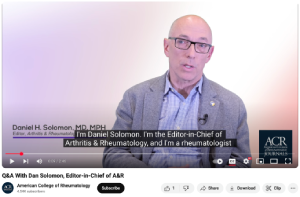There are no hard-and-fast rules in determining what should be published in A&R. Of course, that’s much to the chagrin of many authors, but that’s what an editor in chief has to learn and feel comfortable doing. Fortunately for authors, there are many very good rheumatology journals available. So if A&R turns down an article, authors have plenty of options to get their work published.
TR: A&R has a long reputation as a premier rheumatic disease journal, and it is constantly evolving. One of the newer features is called Notes from the Field, which you started in 2019 with the help of Rick Bucala, MD, PhD, former editor in chief of A&R. [Dr. Bucala is Waldemar Von Zedtwitz Professor of Medicine, professor of Pathology and of Epidemiology & Public Health, chief of the Rheumatology, Allergy & Immunology section at Yale School of Medicine, New Haven, Conn., affiliated faculty, Yale Institute for Global Health, and rheumatologist in chief of the Yale New Haven Health system.] What is Notes from the Field?
Dr. Solomon: Notes from the Field runs about every other month and is a place for commentaries. We are not looking for comments about a published paper. Instead, Notes from the Field provides clinicians, practitioners, researchers and health policy advocates a chance to provide expert opinions on a relevant topic for rheumatology. For instance, we have recently published commentaries on biosimilar prescriptions, long COVID and VEXAS.
TR: Another feature, called Expert Perspectives on Clinical Challenges, has been added to A&R during your tenure. Would you provide a little detail on that?
Dr. Solomon: Expert Perspectives on Clinical Challenges is just as it sounds: clinical review articles about how experts respond to common, but challenging, clinical scenarios—the kinds of scenarios that all clinicians face now and again. For example, this [feature] wouldn’t be an article about how to treat RA, but rather about how an expert clinician treated a patient with RA [that had impacted the lungs] and who wasn’t responding to anything else.
We ask the authors to take us through their logic, to review their practice and to provide the evidence basis for [the therapy]. These reviews recognize that the evidence base is not airtight because these [cases] are usually scenarios in which there aren’t perfect data and the clinician has to infer [therapeutic options] from published papers.




